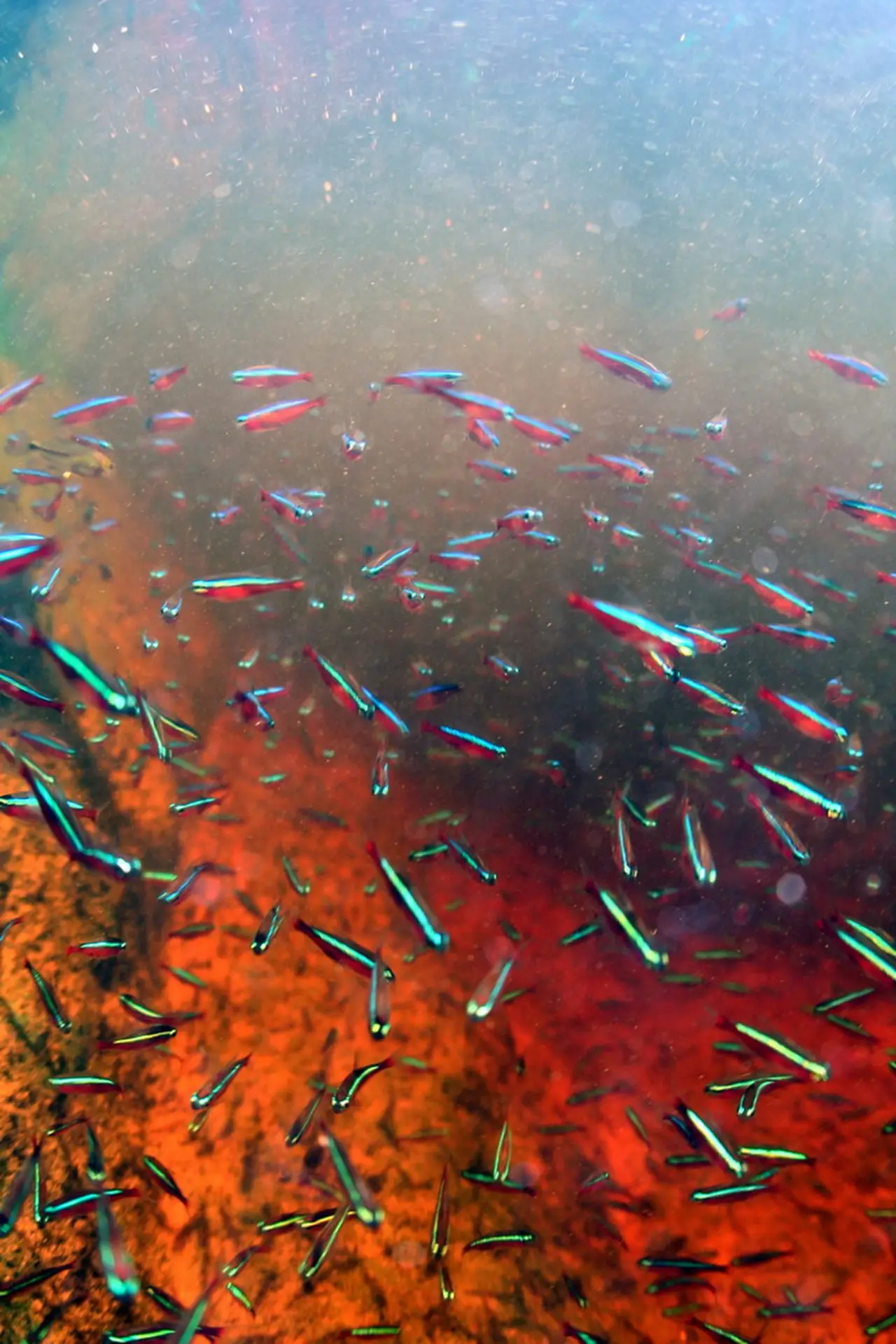Cardinal Tetra

Cardinal Tetras: A Comprehensive Guide to Care, Habitat, and Water Parameters
Cardinal Tetras (Paracheirodon axelrodi) are among the most striking and popular freshwater fish kept by aquarists around the world. Known for their vibrant neon blue and crimson red stripes, these small schooling fish not only bring colour to aquariums but also demonstrate peaceful and engaging behaviour. While they are often mistaken for their close relative, the Neon Tetra, Cardinal Tetras have more extensive red markings and are slightly more sensitive to water conditions.
If you’re considering adding Cardinal Tetras to your community tank, it’s essential to understand their care requirements to keep them healthy, stress-free, and thriving.
Origin and Natural Habitat
Cardinal Tetras originate from the blackwater rivers of South America, particularly the Orinoco and Rio Negro river basins in Brazil, Colombia, and Venezuela. These environments are characterised by:
- Warm, soft, and acidic water
- Dense vegetation and leaf litter
- Low light penetration due to tannins released by decaying organic matter
Replicating this biotope in the home aquarium goes a long way toward ensuring their health and longevity.

Appearance
Cardinal Tetras grow to about 5 cm (2 inches) in length and display:
- A vivid neon blue stripe running horizontally from nose to tail
- A brilliant red stripe running parallel, extending the full length of the body
- Translucent fins, adding elegance to their appearance
Their colouration intensifies in healthy specimens kept under optimal conditions.
Behaviour and Compatibility
Cardinal Tetras are:
- Peaceful and non-aggressive
- Schooling fish, best kept in groups of at least 6–10, though larger groups of 15+ are ideal
- Suitable for community tanks with other gentle species like dwarf gouramis, rasboras, corydoras, and peaceful dwarf cichlids (e.g., Apistogramma)
Avoid housing them with large or aggressive fish that may view them as prey.
Ideal Water Parameters
Below is a table summarising the optimal water parameters for Cardinal Tetras:
| Parameter | Ideal Range | Notes |
|---|---|---|
| Temperature | 23–27°C (73–81°F) | Avoid sudden temperature fluctuations |
| pH | 4.5–6.5 | Slightly acidic; avoid alkaline water |
| Hardness (dGH) | 1–6 dGH | Prefer soft water |
| Ammonia | 0 ppm | Toxic at any detectable level |
| Nitrite | 0 ppm | Also highly toxic |
| Nitrate | < 20 ppm | Keep low through regular water changes |
| Lighting | Low to moderate | Simulates their shaded natural habitat |
| Tank Size | Minimum 60 litres (15 gallons) | For a small group of 6–10 individuals |
Aquarium Setup and Environment
To best replicate their natural environment:
- Use soft, acidic water; consider reverse osmosis (RO) water mixed with blackwater extract or peat filtration.
- Add driftwood, Indian almond leaves, and leaf litter to provide tannins.
- Use dim lighting or floating plants to diffuse light.
- Provide dense plant cover and open swimming areas.
- Maintain excellent filtration and perform weekly water changes (20–30%).
A dark substrate can also enhance their colouration and reduce stress.

Feeding
Cardinal Tetras are omnivorous and accept a wide range of foods:
- High-quality micro pellets or flake foods as a staple
- Supplement with live or frozen foods such as daphnia, brine shrimp, bloodworms, and mosquito larvae
- Feed small portions 1–2 times daily, ensuring all food is consumed within a few minutes
A varied diet helps maintain vibrant colours and overall health.
Breeding
Breeding Cardinal Tetras in captivity can be challenging due to their sensitivity to water conditions and light cycles. However, with careful setup, it is possible:
- Use a separate breeding tank with soft, acidic water (pH around 5.0–5.5)
- Dim lighting or complete darkness is essential during the spawning period
- Condition the breeding pair with protein-rich live foods
- Eggs are light-sensitive; avoid exposing them to light
- Remove adults post-spawning to prevent egg predation
- Fry require infusoria or liquid fry food, followed by baby brine shrimp
Note: Cardinal Tetras are less frequently bred in home aquariums than Neon Tetras and are often wild-caught, making ethical sourcing important.
Health and Common Issues
Cardinal Tetras are relatively hardy if kept in stable conditions. However, they are susceptible to:
- Stress-related illnesses (due to poor water quality or small group sizes)
- Ich (white spot disease) – commonly due to temperature shock
- Tetra disease (incurable, caused by a parasite; prevent by quarantining new fish)
Preventative care is key. Always quarantine new additions and test water regularly.
Final Thoughts
Cardinal Tetras are a jewel of the freshwater aquarium and a joy to watch when kept in optimal conditions. Though they demand slightly more precise water parameters than some other community fish, the rewards are worth the effort.
Their striking appearance, gentle nature, and schooling behaviour make them an excellent addition to a carefully planned, well-maintained aquarium


